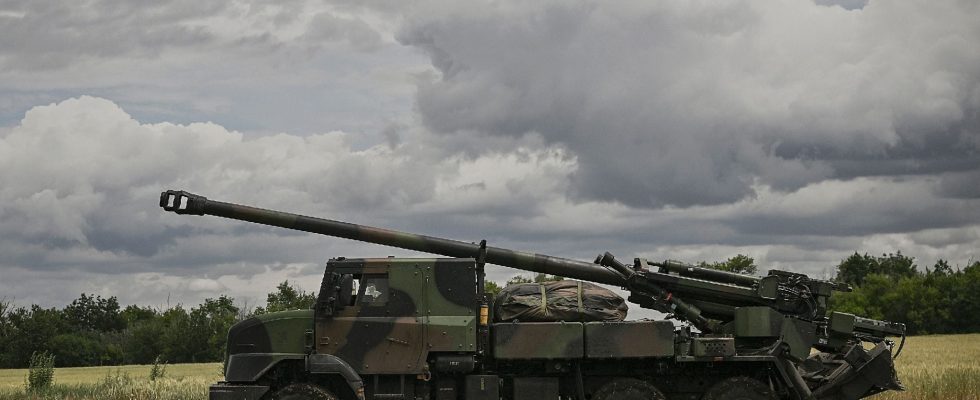For security reasons, the Ukrainian Defense Minister did not travel to Paris this Thursday, January 18, as he had initially planned. It was therefore remotely, thanks to a videoconferencing system, that Roustem Oumerov was able to participate in the official launch of an “artillery coalition” by his counterpart Sébastien Lecornu. Led by France and the United States, this “club” will bring together the upgrade of Ukrainian artillery, an essential tool for resisting Russian forces and reconquering swathes of invaded territories.
As the war will soon enter its third year, France is strengthening its support for Ukraine. Tuesday, Emmanuel Macron announced a new delivery of “forty” Scalp, after those supplied in 2023. The Ukrainians managed to mount these 5 meter long missiles on their Su-24 with a range of more than 250 kilometers, capable of slaloming between Russian defenses to reach their target. They were notably used – or their British twin, the Storm Shadow – on Sevastopol, Crimea, against the headquarters of the Black Sea Fleet and a submarine at dock.
A French missile which has never before been delivered to Ukraine should also equip its air fleet, the president having also mentioned “hundreds of bombs” during his press conference at the Elysée. These would be modular Hammer air-ground weapons: classic bombs from 125 kilos to one ton on which guidance and propulsion devices are installed, for a range of several tens of kilometers at high altitude and 15 at low altitude. – they currently equip the French Mirage 2000 and Rafale.
On land, France announced that it would itself pay the 50 million euros (drawn from the Ukraine fund of 400 million euros already voted) necessary for the production for Kiev of 12 new Caesars, a self-propelled gun with a range of 40 kilometers. Produced by the French group Nexter, it is highly appreciated by Ukrainians for its precision and mobility. They will soon receive six “already purchased”, indicated Sébastien Lecornu. Nexter – capable of releasing six cannons per month from its factories compared to two two years ago – can produce 78 Caesars for kyiv by “early 2025”, the minister specified. “There will remain 60 guns to finance, this is the message that I am sending to all of our allies,” he added.
“France delivers little compared to other supports”
It remains to be seen who will be ready to participate and to what extent. Some voices are being raised to emphasize that France could do more to help Ukraine. The strongest of these is that of the German Chancellor. “The arms deliveries planned so far by the majority of European Union member states to Ukraine are obviously too low,” declared Olaf Scholz on January 8. “I therefore call on our EU allies to also take steps to step up their effort,” he continued – the “also” refers to the doubling of German military aid to Ukraine in 2024, to bring it to 8 billion euros.
In total, Germany’s military aid since the February 2022 invasion would amount to more than 17 billion euros, compared to 500 million for France, according to the Kiel Institute. These are the figures of the promises, which the minister never fails to contest, believing that they underestimate the value of France’s aid.
Nevertheless, the difference between German and French aid is significant, even if it can be explained by the smaller stocks available to Paris. Germany provided battle tanks (Leopard) and anti-aircraft guns (Gepard), unlike Paris (which kept its Leclerc tanks, which are no longer produced, and had no equivalent of the Gepard). According to the Oryx website, it has been delivering IRIS-T short-range anti-missile systems since October 2022 (12 systems planned for 22 launchers) and has already delivered two Patriot long-range batteries. For its part, France delivered two short-range Crotale batteries (an old model) and, with its Italian partner, a long-range SAMP/T system.
“France delivers little compared to other supports for Ukraine, notes Léo Péria-Peigné, researcher at the center for security studies at the French Institute of International Relations. Therefore, financing the 250 million euros of 60 more Caesars that can be manufactured by Nexter would make up a little of this difference in the rankings, but the truth is that France does not want to put a lot of money in. Problem: its partners have the impression that it makes a lot of noise in relation to the quantity of material for which it commits individually.”
It is still necessary to have manufactured enough shells to fuel the Ukrainian cannons. The European Union has set itself the goal of providing them with one million by spring 2024. The count should not be there, with only nearly 500,000 having been delivered to date. “The economy put in place does not live up to expectations,” regretted the president of the Senate Defense Commission, Cédric Perrin, returning from a trip to kyiv at the end of December.
France is making efforts and will increase this month from 2,000 to 3,000 shells delivered per month to Ukraine. To further double this objective, priority is going to the explosives sector, while the demand for such materials is on the rise following the invasion of Ukraine. “We are in the process of getting our hands back on stocks of powder,” explained Sébastien Lecornu. “We are recycling powder on ammunition that has not been used.”
But more will be needed, on a continental scale, to supply kyiv to meet its needs in the face of a Russia that has fully mobilized its defense industry. “The 500 million euros of the European financing plan for munitions, ASAP, distributed to the various manufacturers, does not carry enough weight, much greater investment is needed,” notes Léo Péria-Peigné. The Ukrainians were firing between 5,000 and 8,000 shells per day in December, said Cédric Perrin. Against between 10,000 to 15,000 on the Russian side.
.
